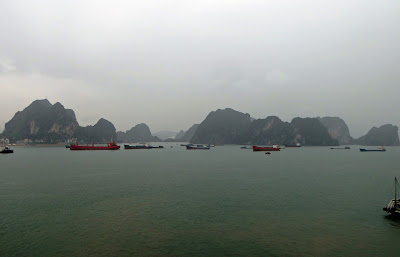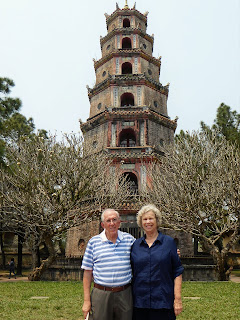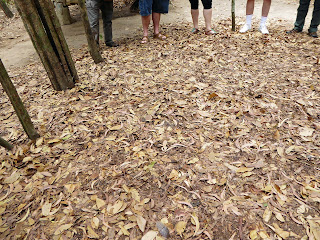Unfortunately, we didn’t arrive until about 1:15 pm, due to an overnight engine problem on the ship. Passengers were told to meet their excursion where the buses were parked outside the terminal. Chinese Immigration regulations required a face-to-face inspection for everyone on the ship to ensure that all guests possessed an approved Chinese visa, even if they weren’t going on a shore excursion. The end result was everyone tried to leave the ship at the same time, and there was a very long line of guests in the terminal going through the immigration formalities. We didn’t get through the line and to our bus until about 2:00 pm for our tour, titled “Panoramic Xiamen.”
Before now, we had never heard of Xiamen, so we had no idea what to expect. We were pleasantly surprised that the city is so large, modern, and attractive, with a population of 3.5 million people. We were told that Xiamen has long been an active port city. The name sounds like “Chah - men” (emphasis on the first syllable)
A very quick history lesson – Xiamen became a foreign treaty port after the First Opium War in the 1800s. The treaty at the end of that war (1842) ceded the island of Hong Kong to the United Kingdom, and it established five “treaty ports” in China, including Shanghai and Amoy (the “Western” name for Xiamen back in those days). Foreigners were permitted to live and trade in these specific Chinese ports.
The city of Xiamen and the island have the same name. The close, offshore island of Gulangyu is administratively part of Xiamen and historically was a foreign zone with consulates and luxurious homes. We weren’t able to visit Gulangyu, but we understand that it’s scenic and quiet (no gasoline-powered vehicles allowed) with some beautiful, old colonial buildings. We did see the terminal in downtown Xiamen for the 5-minute ferry boat ride over to Gulangyu. There are four bridges and one tunnel that connect Xiamen with the Chinese mainland.
In the 1970s, and again when China began economic reforms in the mid-1980s, Xiamen was named as a Special Economic Zone open to foreign investment and trade. Since then Xiamen seems to have flourished. We read that Xiamen is now one of the largest ports in China, in terms of cargo movements. During our excursion we observed a Chinese naval base on Xiamen. We assume that the mission of that base must involve defense of the Taiwan Strait.
Our young, female tour guide, Max, was proud that Xiamen has been ranked as China’s second “most suitable city for living.” She also pointed out the green trees in this city, as compared to how gray it is up north.
The Panoramic Xiamen excursion began at Bailuzhou Park, which is a nice-looking green space in the heart of the city. We admired the large lake (with boats for rent) and an “Egret Goddess” statue. We were told that the Chinese nickname for Xiamen is Egret Island. There was also a nice statue of a dragon boat being raced. This park looked like a great destination for local people as a peaceful place to relax.
Next we rode along a coastal highway, which our guide called the “Ring Road.” It was a very nicely landscaped, modern highway. The road separates new, large high-rise apartment buildings on one side and a few large resort hotels and beaches along the Taiwan Strait on the other side of the highway.
We stopped at one of the beaches and admired the views and statues there. There are hundreds of bicycles-built-for-two (and three) available for rent at public beaches, and we saw many of them being ridden – it looked fun. Along the Ring Road we also had glimpses of distant islands, such as Jinmen (formerly known as Quemoy), which is still governed by Taiwan. We understand that riding a ferry boat between Xiamen Island and Jinmen Island is now allowed, but we weren’t told any more details.
We were running short of time, as we were supposed to be back on the ship by 5:30, but we were allowed 40 minutes to stroll through a popular shopping street near the ferry terminal (Zhongshan Road) which is a street closed to traffic and lined with many small shops ranging from inexpensive jewelry, candy, tea, food items, to some brand-name stores. Ginny made a small purchase at Miss Zhao’s Tea and Cake Shop – two sets of decorative, gold-colored tea fork and spoon. Some of the people in our group were late returning from shopping, so we just barely made it back to the ship before 6:00 pm.
Hong Kong it’s not, but Xiamen does have a modern, vibrant, busy feel. We didn’t have time to visit many of the other appealing parts of town, including Xiamen University, a large Buddhist temple, Water Garden Expo Park, and “the biggest private art gallery in China.” Maybe next time!
Next stop Shanghai, after one day at sea.
Jim & Ginny


















































